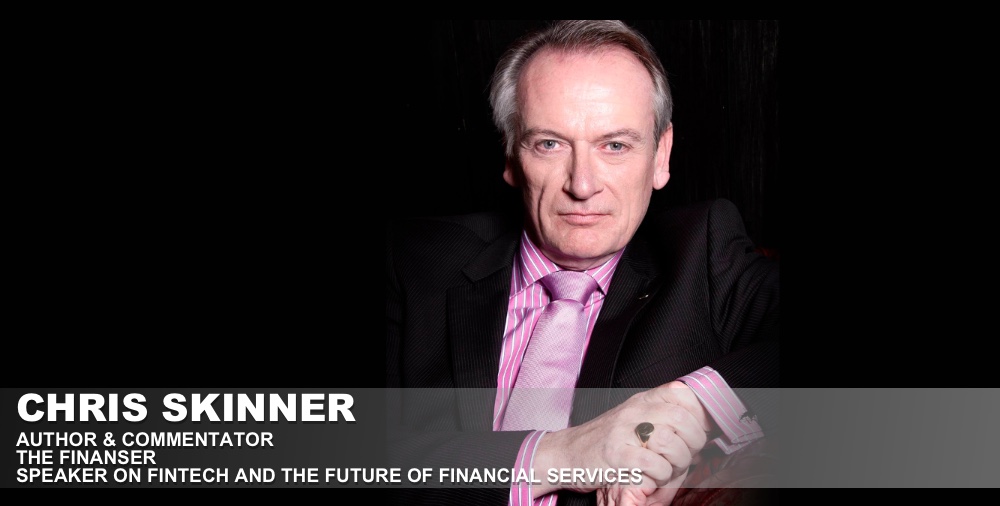
Challenger banks don’t matter as they’re not a primary account – an article written on Chris Skinner’s blog by himself (photo).
During Money 2020 Europe, I bumped into a chap from Monzo. No names mentioned, but he was buzzing and no wonder. The start-up has just boomed through two million users and is growing at over 60,000 account openings a week or 10,000 per day.
Some think that number seems high, but they may have missed the fact that last month Monzo began TV advertising. New account openings have doubled as a result.
I tweeted this and got an interesting reply which effectively asked: “are these real accounts or just testers?” (How you define main account? Used as discretionary spending or where income paid or closed other account and switched etc?)
It’s a valid question, and one asked by many. How many of these two million accounts are primary, secondary, tertiary or test accounts? The problem with that question is how do you define a primary account?
Most traditional banks define a primary account as the one you have your salary paid into. This was articulated well in an article the other day:
Just over one in 10 (12%) Brits have fully switched to a digital only bank, according to personal finance comparison site finder.com. Furthermore, nearly half (47%) of those who do use them keep less than £1,000 in them. Two-thirds of banking customers say they plan to convert fully to digital banks in the future, meaning having their salary paid in and direct debits paid out.
… but that definition is wrong. It’s wrong because an account that has your salary paid may be just a transactional account and not a lifestyle account.
Oh-oh. Two accounts?
Sure, two accounts. An increasing number of digital challenger bank customers are using these banks for their discretionary lifestyle spending and leaving their boring transactions with their old bank. The issue this creates for boring old bank is that all they see is payments for taxes, utility bills and other annuity services, but none of your payments for things you enjoy in your life such as entertainment, consumption and lifestyle.
Before you know it, the big banks will just see statements that say: Monzo (auto top-up) £200.00. You know that I am doing things on Monzo, but you have no idea what, why or where I’m doing it. In other words, the financial intermediary who never believed they would be disintermediated, has been disintermediated by a new intermediator. A data intermediary.
And this is exactly what is happening with these two million users. According to Monzo, most customers are making an average monthly deposit of £1,000 per month and using it for their personal financial management (PFM) to analyse their discretionary lifestyle spending.
The earlier report corroborates this:
Laura Suter, personal finance analyst at investment platform AJ Bell, believes this is because many use these accounts for ‘shoeboxing.’
“Take-up of digital banks has been pretty impressive, but few people are making the full leap to have all of their finances with these app-only banks – users are held back by a mixture of mistrust, apathy and ‘shoeboxing,’ she says.
“People increasingly see bank accounts as a little pot for a certain area of their life. They will use the likes of Monzo or Starling for their everyday transactions, so they can use the apps to analyse their spending, but they want to keep this data separate from their salary or their council tax bill.
“This ‘shoebox mentality’ when it comes to accounts can be smart. You can have a digital bank for your everyday spending and to analyse where your money goes, and then use another account to meet the regular boring bills that come in each month.”
Over time, the issue with letting challengers steal the data about customer behaviours means that boring old bank is left with the utility bills as a pure utility that, when you have your main relationship with the newbie, is easily deleted.
About the author
Chris Skinner is one of the top global Fintech influencers and an authoritative voice on the future of the financial services sector. Probably he is one of the most brilliant minds in banking. He highly respected as an independent commentator on the financial markets and fintech through his blog, the Finanser.com, as author of the bestselling book Digital Bank (2014), Value Web (2016) and its new sequel Digital Human (2018), and describes himself as a strategist, communicator, entrepreneur, innovator & provocateur.
He is the author of seven books, though it is his last three which have made most significant impact: Digital Human: the fouth revolution of humanity includes everyone (2018). Digital Bank: strategies to launch or become a digital bank (2014) tracks the innovations in banking and how the mobile internet is changing the dynamics of consumer and corporate relationships with their banks. ValueWeb: how Fintech firms are using mobile and blockchain technologies to create the Internet of Value (2016) is a sequel to Digital Bank.
Chris is known to be an exceptional speaker. He regularly opens as keynote at many private industry events. He provides keynote speeches to financial industry conferences, to fintech and innovation summits, to client conferences and provides in-company briefings. He is also a highly effective moderator drawing upon his knowledge, research and experience. His keynote addresses focus upon the key current trends and future scenarios for all areas of financial services across retail, commercial and investment banking, as well as wider areas of the future of society and the economy.
Banking 4.0 – „how was the experience for you”
„To be honest I think that Sinaia, your conference, is much better then Davos.”
Many more interesting quotes in the video below: